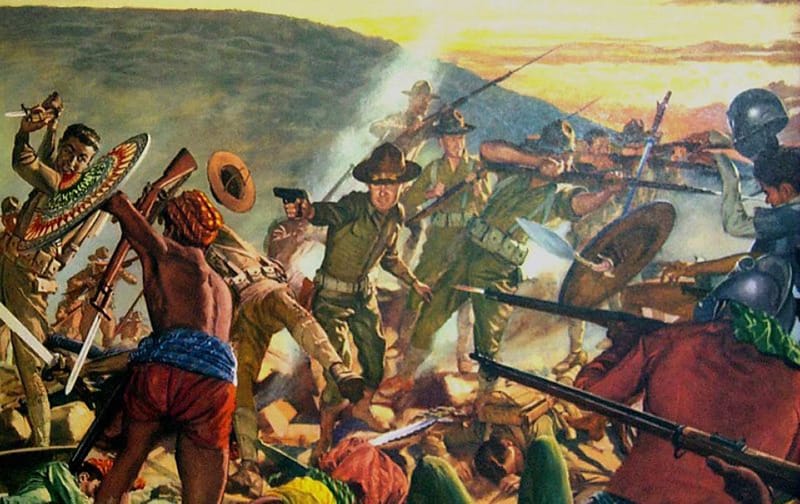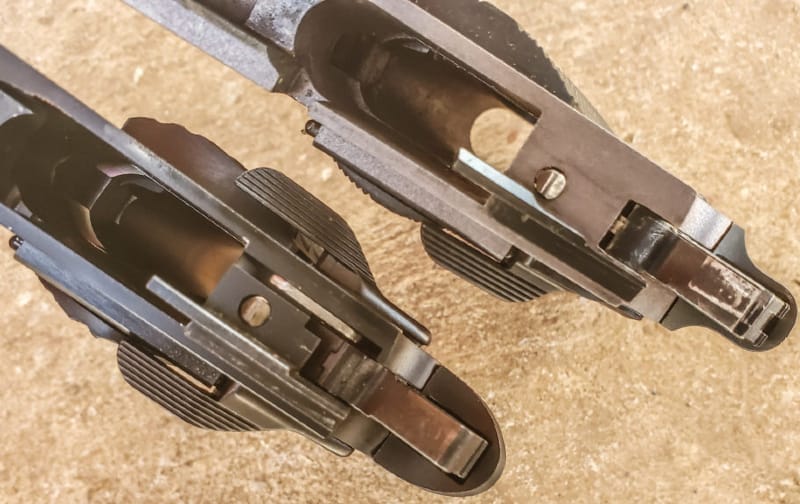Even if you’re not a 1911 aficionado, you might have noticed a lot of guns being advertised as either “Series 70” or “Series 80.” If you love 1911s, the odds are good that you have strong feelings on this subject. Many people say the biggest difference between the two series of 1911s has to do with the safety mechanisms, and they’d be right, to a point. In reality, there are quite a few differences between a 1911 Series 70 vs Series 80, and we’re here to help you navigate the waters of design change.

What is a 1911?
It might seem odd to include this, but remember, we were all new once. 1911s are hammer-fired, semi-automatic handguns with identifying features such as grip safety, external thumb safety, and a single-action trigger. Originally, M1911s were chambered in 45 ACP, but today they’re produced in everything from 380 ACP to 10mm and beyond.
The 1911 was designed by a firearms inventor some refer to as “Saint” John Browning in response to a demand for a new service pistol for the United States military. This occurred due to a chain of events that started in the late 1800s. In 1899, the United States was fighting in the Philippine-American War, which came about on the heels of the Spanish-American War. The challenge in that war came from the Moro Rebellion.
The Moro Rebellion

The Moros were frequently seen as fierce fighters, but the Juramentados among them were truly crazed. “Juramentados” is a Spanish word that roughly translates to “one who takes an oath,” and members of that faction were zealous in their actions, to say the least. It was a Muslim faction with a desire to take out those seen as Christians invading their land—this is a simple fact, not a matter of religious opinion—and aside from their religion-borne fervor, they took a lot of drugs. Those narcotics and hallucinogens not only gave them an extra dose of bravery for battle but a total disregard for pain. That’s what the United States Cavalry discovered when they tried shooting them to stop an attack: nothing happened; they just kept on coming.
Before the 1911
At that time, the service gun for cavalry members was mostly double-action revolvers chambered in 38 Long Colt. Those guns and the cartridge they were chambered in failed entirely. Service members could empty their revolvers into the attacking Moros, and their assailants remained coherent and functional enough to continue their onslaught, even beheading the men who had repeatedly shot them. Clearly, something had to be done, so the United States military opened studies and pistol competitions, all designed to find a suitable replacement for their old revolvers.

There were others involved in those early pistol trials, but Browning’s 1911s really shone. During the tests, the guns were drenched with acid, buried in piles of mud, and thrown in bodies of water. Cleaning and cooling times were infrequent, yet the 1911s continued cycling. In the end, it was the winning design, and the M1911 was born. That was, of course, in 1911, and a lot has happened since then.
What’s a Series 70 1911?

The Colt 1911 Classic Series 70 Government remains a popular gun, even with the later creation of the Series 80. That gun harkened back to the first M1911, which they had altered in 1924, so the mainspring housing would be arched, and the grip safety was longer. After those changes, it became the M1911A1. In the 1970s, people started filing lawsuits against manufacturers revolving around those Series 70 1911s. It wasn’t just the Colt 1911 Classic Series 70 Government getting negative attention; it was Series 70 guns in general.
As a result of the lawsuits, Colt stopped producing Series 70 1911s around 1983. It would eventually be back, but the modernized versions would be accurately called replicas.
Bottom line? The Series 70 1911 lacked some of the safety measures the later Series 80 would have worked into its design. Of note is the fact that many 1911 fans say there is a significant difference in how the different series pistols feel during live fire, which makes sense because some changes did indeed affect the action. While I’d agree there are nuances in how the triggers of the two series feel, both run smoothly.
What’s a Series 80 1911?
1911s, known as Series 80 guns, resulted from changes made to the pistols in the early 1980s. By 1983, when the Colt 1911 Classic Series 70 Government—and all Series 70 1911s—had its production halted, the Series 80 guns were ready to go. Most modern 1911s are Series 80, but not all. For example, companies like Ruger make their own version of the Series 70 guns. They aren’t exact duplicates, though; Series 70 1911s made today are definitely improved a bit over the originals. One way gun makers have changed things up is by using titanium firing pins in their Series 70s.
Differences between a 1911 Series 70 vs Series 80:

Here’s a general rundown:
- Series 70 have a collet bushing; Series 80 have standard barrel bushings.
- Series 70 didn’t have a firing pin safety; Series 80 have firing pin blocks for additional safeties.
- Series 70 didn’t have a metal lift as part of the safety mechanism; Series 80 have a slim metal lift that presses a safety plunger within the slide, deactivating the aforementioned firing pin block safety.
- Series 70 guns weren’t considered drop safe; Series 80 guns have additional safeties to be drop safe.
- Series 70 have half-cock hooks on their hammers, requiring precise use to function correctly; Series 80 pistols have a half-cock shelf that’s easier to use.
- Series 70 have an arched mainspring which was a change from the flat mainspring they were first made with prior to the M1911A1 designation; Series 80 guns went right back to the original flat mainspring housing.





The 1911 Trigger
It’s true that the triggers are different on a 1911 Series 70 vs Series 80, but that’s fixable. There are a number of things a competent gunsmith can do with a 1911 trigger, so if you have a Series 80 1911 with a trigger you hate, get it customized. There is some creep and resistance to Series 80 triggers that weren’t present in the old Series 70 guns but just as with any firearm; it depends on the manufacturer. Yes, the changes to the safety mechanisms impact the trigger pull, but certain gun makers produce nicer triggers than others regardless of the series.
Whether you get a 1911 Series 70 vs Series 80 is entirely up to you. If you have trouble choosing, consider this: why not get both? After all, there’s no such thing as too many guns.


